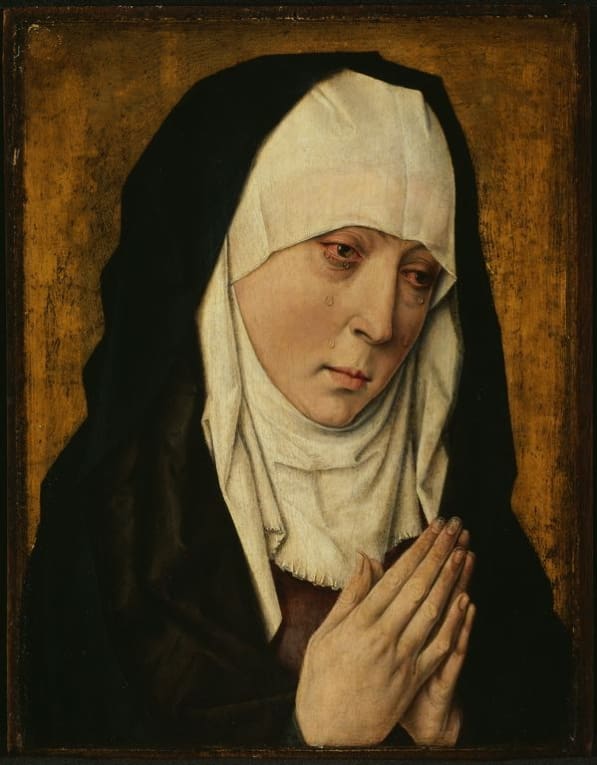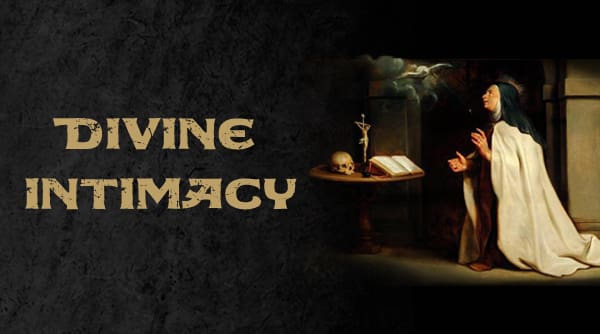The Seven Sorrows of Mary
Presence of God – Permit me, O Mary, to remain near the Cross, that I may share with you in the Passion of Jesus.
MEDITATION
We find in Simeon’s prophecy the first explicit announcement of the part the Blessed Virgin was to have in the Passion of Jesus: “Thy own soul a sword shall pierce” (Luke 2:35). This prophecy was fulfilled on Calvary. “Yes, O Blessed Mother,” says St. Bernard, “a sword has truly pierced your soul. It could penetrate Your Son’s flesh only by passing through your soul. And after Jesus had died, the cruel lance which opened His side did not reach His soul, but it did pierce yours. His soul was no longer in His body, but yours could not be detached from it.” This beautiful interpretation shows us how Mary, as a Mother, was intimately associated with her Son’s Passion.
 The Gospel does not tell us that Mary was present during the glorious moments of the life of Jesus, but it does say that she was present on Calvary. “Now there stood by the Cross of Jesus, His Mother, and His Mother’s sister, Mary of Cleophas, and Mary Magdalen” (John 19:25). No one had been able to keep her from hastening to the place where her Son was to be crucified, and her love gave her courage to stand there, erect, near the Cross, to be present at the sorrowful agony and death of the One whom she loved above all, because He was both her Son and her God. Just as she had once consented to become His Mother, so she would now agree to see Him tortured from head to foot, and to be torn away from her by a cruel death.
The Gospel does not tell us that Mary was present during the glorious moments of the life of Jesus, but it does say that she was present on Calvary. “Now there stood by the Cross of Jesus, His Mother, and His Mother’s sister, Mary of Cleophas, and Mary Magdalen” (John 19:25). No one had been able to keep her from hastening to the place where her Son was to be crucified, and her love gave her courage to stand there, erect, near the Cross, to be present at the sorrowful agony and death of the One whom she loved above all, because He was both her Son and her God. Just as she had once consented to become His Mother, so she would now agree to see Him tortured from head to foot, and to be torn away from her by a cruel death.
She not only accepted, she offered. Jesus had willingly gone to His Passion, and Mary would willingly offer Her well-beloved Son for the glory of the Most Holy Trinity and the salvation of men. That is why the sacrifice of Jesus became Mary’s sacrifice, not only because Mary offered it together with Jesus, and in Him, offered her own Son; but also because, by this offering, she completed the most profound holocaust of herself, since Jesus was the center of her affections and of her whole life. God, who had given her this divine Son, asked, on Calvary, for a return of His gift, and Mary offered Jesus to the Father with all the love of her heart, in complete adherence to the divine will.
COLLOQUY
“O Mary, Mother of Jesus Crucified, tell me something about His Passion, for you felt and saw it more than all the others who were present, having contemplated it with the eyes of your body and soul, and given it all the attention possible, O you who love Him with such great love” (St. Angela of Foligno).
“O Mary, grant that I may stand with you near the Cross; permit me to contemplate with you the Passion of your Jesus, and to have a share in your sorrow and tears. O holy Mother, impress deeply in my heart the wounds of the Crucified; permit me to suffer with Him, and to unite myself to your sorrows and His” (cf. Stabat Mater).
“O Queen of Virgins, you are also the Queen of Martyrs; but it was within your heart that the sword transpierced you, for with you everything took place within your soul.
“Oh, how fair you are to behold during your long martyrdom, enveloped in a majesty both strong and gentle; for you have learned from the Word how those should suffer who are chosen as victims by the Father, those whom He has elected as associates in the great work of the redemption, whom He has known and predestinated to be conformed to His Christ, crucified for love.
“You are there, O Mary, at the foot of the Cross, standing, in strength and courage; and my Master says to me, ‘Ecce Mater Tua.”’Behold your Mother. He gives you to me for my Mother! And now that He has returned to His Father, and has put me in His place on the Cross so that I may fill up those things which are wanting of the sufferings of Christ in my flesh for His Body, which is the Church, you are still there, O Mary, to teach me to suffer as He did, to let me hear the last song of His soul which no one but you, O Mother, could overhear” ([Saint] Elisabeth of the Trinity, Last Retreat, 15).
That my desire for suffering will not be sterile, help me, O sweet Mother, to recognize in each daily suffering the Cross of your Jesus and to embrace it with love.
+
 Note from Dan: This post on the seven sorrows of Mary is provided courtesy of Baronius Press and contains one of two meditations for the day. If you would like to get the full meditation from one of the best daily meditation works ever compiled, you can learn more here: Divine Intimacy. Please honor those who support us by purchasing and promoting their products.
Note from Dan: This post on the seven sorrows of Mary is provided courtesy of Baronius Press and contains one of two meditations for the day. If you would like to get the full meditation from one of the best daily meditation works ever compiled, you can learn more here: Divine Intimacy. Please honor those who support us by purchasing and promoting their products.
Art for this post on the seven sorrows of Mary: Mater Dolorosa (Sorrowing Virgin [Sorrowful Mother]), Workshop of Dieric Bouts, between circa 1470 and 1475, PD-US author’s life plus 100 years or less, Wikimedia Commons. Father Gabriel of St. Mary Magdalen, mirror from open source material.




